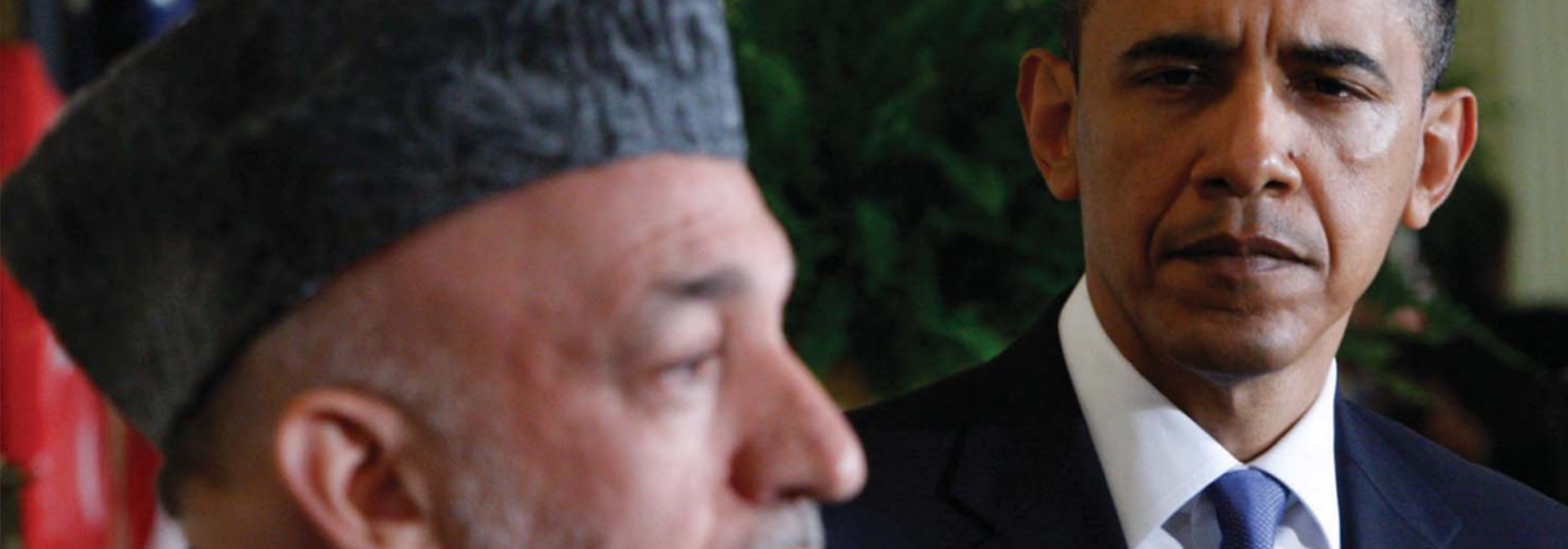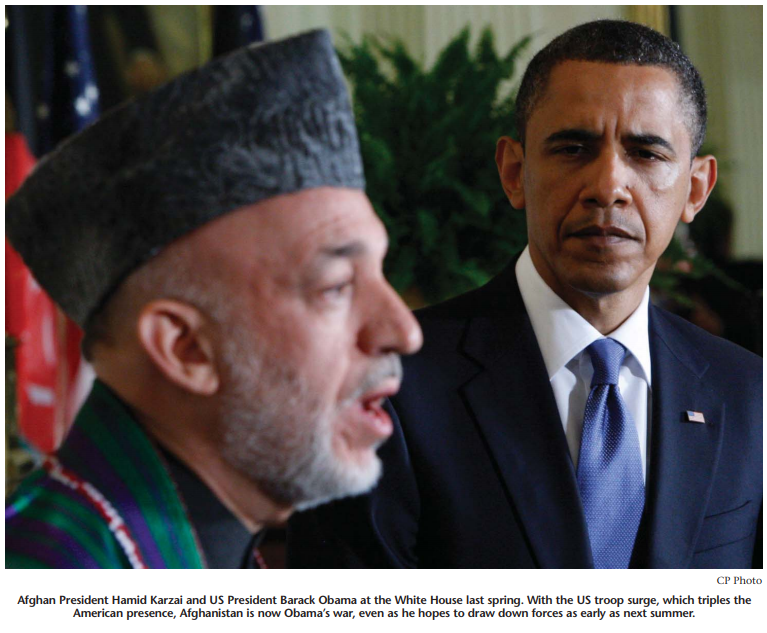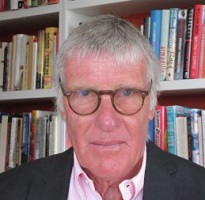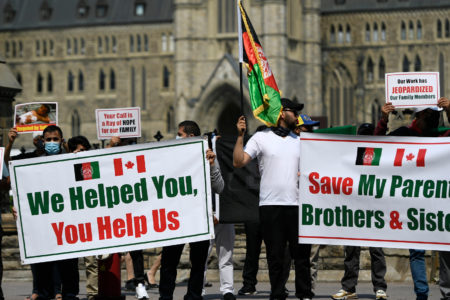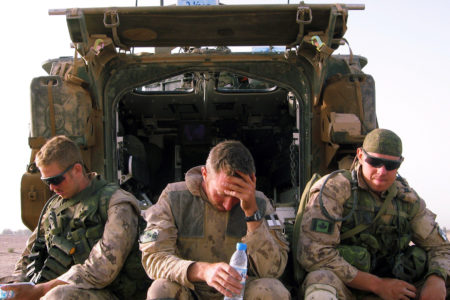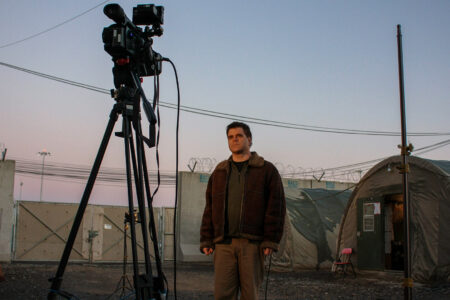
It is nine years since US forces swept over Afghanistan in the aftershock of 9/11 to pay back the jihadists of al-Qaeda and put down their compliant Taliban hosts.
It has been their longest war in history and there is not really an end in sight, despite a presidential exit strategy that was part of the increase of 30,000 troops a year ago. That increase is only now moving onto the ramp.
For Afghans it has been a 40-year nightmare of coups, uprisings, invasion from Russia, civil war among warlords and mujahedeen. The Islamic extremist Taliban bestowed a certain stability in the 1990s but extended the nightmare of a traumatized people in another direction that Dexter Filkins captures in The Forever War: “It seemed obvious enough that what lay at the foundation of the Taliban’s rule was fear, but not fear of the Taliban themselves, at least not in the beginning. No: it was fear of the past. Fear that the past would return…that the past would become the future. The beards, the burqas, the whips, the stones; anything, anything you want. Anything but the past.”
Historical writers relish Afghanistan’s narrative of conflict among its four ethnic tribes and multiple subdivisions of local warlords who seemed to come together only to repulse foreigners, most famously during three wars against British invaders in the 19th century.
But the US occupation today is more apt to be compared to the failed Soviet attempt to shore up the power of a cooperative and secular Afghan state over tribal and sectarian strongholds, resistant to rule from Kabul as much as to rule from outsiders.
There was a shot at a measure of stability in 1989 when the foreign minister of the reforming and departing USSR, Eduard Shevardnadze, sought US and Pakistani support for a temporary power-sharing arrangement between the Afghan Communist regime and rebellious mujahedeen to enable the country breathing space after the Soviet exit to smooth the transfer of power to Afghans. Both the US and Pakistan turned away, for differing reasons that haunt the landscape today. There is an irony now as necessity drives the US to pursue an elusive power transfer strategy of its own.
In 1989, however, the US welcomed the Soviet Afghan defeat as a reward it had worked for. Once the Cold War ended, Afghanistan ceased to matter. The US viewed with indifference the vacuum that became consumed by the fire of a civil war among mujahedeen and warlords that lasted until 1996, when the Taliban took over much of the country and imposed one of the harshest versions of Sharia law ever seen in the Muslim world.
Pakistan had welcomed chaos in Afghanistan if it kept the country from becoming an ally of Pakistan’s existential enemy on its other side, India. Pakistan, through the Inter-Services Intelligence (ISI) Directorate, then worked to help install the Taliban for the same reason. It would prefer a Taliban regime even now as the Taliban fight its American ally. The inherent misalliance between the US and Pakistan is the biggest of several obstacles to resolving the long-standing agonies of Afghanistan today.
Every war needs its narrative, and the pursuit of al-Qaeda and the excision of its launch pad and haven, represented by a seemingly grotesque Taliban regime headed by the overtly hostile Mullah Omar, virtually wrote itself, at least for North American consumption.
It was a righteous war, also seen by Europeans as one of necessity. Indeed, NATO allies proposed in the days after 9/11 to make it an “article 2 war,” in collective self-defence. But the US recalled with distaste the hobbling experience a few years earlier of NATO’s “war by committee” against Serbia. This time, in its anger and its pain, the US impulse was to go it alone.
NATO did become involved, though the alliance never lived up to its promises, despite the outsized sacrifices of a few of its members in the years to come. On December 20, 2001, the UN Security Council approved deployment to destroyed Kabul of a NATO-centred force (the International Security Assistance Force) of 3,000 to 5,000 soldiers whose mandate was essentially peacekeeping. The Americans, meantime, kept up the hot pursuit of their fugitive enemies. Though the Americans lost Osama Bin Laden and al-Qaeda leaders in the wasting landscape of Tora Bora, the Taliban imploded as a force and within months had fled from their last Pashtun stronghold in Kandahar.
On December 22, British marines landed at Bagram air base to escort the newly designated Hamid Karzai to his inauguration as interim leader of the liberated country.
Every war needs its narrative, and the pursuit of al-Qaeda and the excision of its launch pad and haven, represented by a seemingly grotesque Taliban regime headed by the overtly hostile Mullah Omar, virtually wrote itself, at least for North American consumption.
Karzai was a relatively minor Pashtun tribal leader whom the US saw as a figure apt to conciliate and bridge tribal and other differences. The US pushed him forward to a hastily convened but enthusiastic international conference in Bonn in November 2001 that aimed to establish institutions and a process for the country that had not had a nationally agreed government since 1979. Afghans themselves were less enthusiastic: Pashtuns claimed underrepresentation in Bonn, and various prominent fighters against the Taliban were excluded, such as Generals Dostum and Khan. and hardline Islamist Gulbuddin Hekmatyar. The Taliban obviously were absent.
Conference themes reassuringly promised a light footprint for international forces and a quick exit. The international community foresaw legislative and presidential elections leading the way to democratic governance and national self-sustainability without foreign military presence. Judicial and constitutional commissions were created. Karzai (also absent from Bonn) was awarded a mandate to lead interim and transitional authorities for two and a half years, after which elections would be called. A loya jurga, a form of Afghan traditional consultation, would be assembled to ratify the international agreement. The donor countries pledged large sums to support reconstruction and development.
What went wrong? “The goal of creating a liberal twenty-first century democracy with western values was and is excessive,” commented Ron Neumann, a former US ambassador. A multiple Canadian ambassador in the Muslim world, Michael Bell, cut closer to the chase when he wrote in The Globe and Mail, “Some problems can’t be solved, no matter how desirable that might be in terms of our values and economic interests. Societies may be dysfunctional and their governments intolerant and oppressive, but the core question is what, if anything, outsiders can do about it.”
And yet Afghanistan was not always dysfunctional. In the 20th century, various leaders, most notably Amanullah Khan (1919-29), who declared Afghanistan’s complete independence and launched a constitution with citizens’ rights, tried to modernize the country and to strengthen the national state. During the long if ambivalent reign of Mohammed Zahir Shah (1933-73), more modernization attempts were made amid general peace. But Zahir Shah was forced out by a coup in 1973 that began the downward spiral into chaos.
The harsh Afghan truth is that pressure from above for rapid social change has always met with heavy conservative resistance. There is progress: since 2001, the number of children in school has risen from 1 million to 9 million, including millions of girls. Five million refugees have been re-absorbed. But deeply rooted sectarian push-back will make any transformative reforms supported by NATO allies difficult to achieve nation-wide for some time to come.
Bob Woodward, in his new book Obama’s Wars, cites the President’s recognition that realizing a “Jeffersonian democracy” in Afghanistan would be a fantasy. But a minimum goal essential to any definition of success is the building of a sustainable national state with broad popular support. Without it, there could be no transfer of capacity to oppose the clearly undemocratic and hostile Taliban.
State-building efforts have thus far failed. Live-in Afghan authority Rory Stewart, now a British MP, described in the New York Review of Books in January how the UK development ministry poured 80 percent of its sizable aid budget for Afghanistan directly into budgetary support, on the assumption it would be possible within about seven years to “build a stable centralized state, largely independent of foreign support, arranged around the rule of law and a technocratic administration… Few expected the Taliban to reemerge…Eight years later this seems a tragic fantasy…The British government that once championed more generous budgetary support for the Kabul government now portrays it as corrupt, semi-criminal, ineffective, and illegitimate” [emphasisis added].
Such language points to a key behavioural part of the problem. But Afghanistan would not be such a mess were it not for the diversion of US attention in early 2003 to the entirely unnecessary invasion of Iraq. The disastrous mayhem the ill-prepared and badly implemented US occupation of Iraq caused, including to American interests, starved the Afghanistan deployment and effort of resources, attention and, ultimately, success. As Bruce Riedel, who was centrally involved in White House assessments of the war from the Bush years into the Obama tenure, reported to a Centre for International Governance Innovation conference this year, “Obama inherited a war in Afghanistan that was unsuccessful, under-funded and lacked a clearly defined strategy.”
The Taliban did, of course, reemerge while US attention was on Iraq. From just fumes left from their defeat and collapse in 2001-02, they built a force of over 25,000 fighters who signed up for jihad or who just took the only jobs on offer. Taliban control went from only 30 out of 364 districts in 2003 to 164 districts in 2008, according to military expert Anthony Cordesman.
It took a long time for the outsmarted Western military to get what was really going on, including in former Taliban strongholds such as Kandahar to which the Canadian military had confidently deployed with virtually no local knowledge. The incoming chief of defence staff, General Walter Natynczyk, told a Victoria audience after his first trip to Afghanistan in 2008 that the military prognosis was definitely improving, just when (as reported by Ahmed Rashid in the New York Review of Books) US military commanders were telling President Bush things were going “from bad to worse.” For Natynczyk’s predecessor, General Rick Hillier, Canada’s military mission was to take out Taliban “scumbags and murderers,” but as US Generals Petraeus and McChrystal both publicly acknowledged, it became clear there would be no way the coalition could shoot its way to victory.
Lousy outsider readings of the local situation have always been the way in Afghanistan. Foreign troops were isolated by an understandable focus on force protection. Photo ops of soldiers repairing village wells pretended they weren’t isolated from the Afghan people, but Woodward reports McChrystal acknowledged when he arrived in 2008 that the “intelligence operation [was] in shambles.”
Though the US military understood relatively little about Afghanistan, two central and enduring facts about the Taliban’s progress were becoming blindingly obvious: their success was in direct proportion, first, to public cynicism caused by the corruption and ineffectiveness of the Karzai government and, second, to the support and safe havens provided by Pakistan.
Security, democracy and development are interdependent but without security, the others can’t grow. In the visible presence of an antidemocratic and corrupt government, the Taliban’s political and propaganda gains eroded popular belief that the battle was over security rather than spoils, which further undermined security. Add the corrosive impact of poppy cultivation and the outlandish rewards of trade in drugs (25 percent of the GDP), and a truly vicious circle was closed.
By most up-close accounts, President Karzai comes across as a volatile and paranoid personality with the moves of a con artist. His defenders would argue that in the politically fragmented landscape of Afghanistan, the only management technique is to try to play sides off against each other. Karzai courts the nationalist domestic audience by making their grievances appear as his own, and he soft-sells them to believing foreign audiences such as the self-nominated soulmates around Governor General Michaëlle Jean’s dining table when Karzai came to Ottawa to visit in 2006. Karzai’s apologists add that without clear lines of power from the centre, he can’t be picky about the allies he needs in the provinces. But some, such as his half-brother Ahmed Wali Karzai, the governor of Kandahar, are out-and-out crooks. Tragically, Ahmed Karzai has also been on the CIA payroll for years which says a lot about the destructiveness of US inconsistency.
There are honest officials in Afghanistan but President Karzai’s deals often aim to take them down. The British were very supportive of the modernizing and anti-corruption campaign of Governor Gulab Mangal of Helmand province, where their troops were under heavy pressure. Karzai tried to replace him with a pliant crony. Whatever Karzai’s intentions, his government, in General Petraeus’ words, is a “criminal syndicate.”
He won re-election in August 2009 by fraud. Ballot stuffing, forged ballots and fake polling sites amounted to over a million extra votes for the incumbent, Karzai, over Dr. Abdullah Abdullah. Karzai got caught and got away with it and yet seems more resentful than ever.
As to the people, there is a difference of view between those like Scott Worden, one of the three UN-appointed commissioners of the elections complaints commission, who writes in the Journal of Democracy (July 2010) that “postelection polls show that most Afghans believe that widespread fraud occurred, yet also think that Karzai won legitimately and deserves to be recognized as president,” and the many in Washington and elsewhere whom Woodward quotes to the effect that Karzai’s theft of the election undermined Afghan trust in the West and in democracy, to the Taliban’s advantage.
Perhaps that helps to explain the survey finding cited in a recent edition of Harper’s that only 1 percent of Afghans believe that NATO forces are in their country to help rebuild it.
What about Pakistan? Are they happy about US forces being in Afghanistan? The Pakistanis’ absolute priority is that Afghanistan never fall under the sway of their arch enemy, India. To the extent that Pakistan is not convinced the US will stay in Afghanistan, then the Pakistani hedge is to support the Islamist Taliban.
Long-time authority Chris Alexander, who writes elsewhere in these pages, told anybody who might listen during the several years he was in Afghanistan for Canada and then for the UN that Pakistan’s role was inherently and operationally destructive. Sadly, few did listen until the last few years. Today, the Obama administration totally gets it, but the Pakistanis are still taking billions of aid dollars from the US while continuing to give sanctuary and support to the Afghan Taliban. There has been a belated recent Pakistani effort to take the fight to Taliban safe havens and training grounds in the borderland tribal areas of Pakistan, but it remains unconvincing because the Pakistanis are themselves unconvinced the US is in Afghanistan for the long haul.
US preoccupations over the behaviour and even stability of nuclear-armed Pakistan extend beyond Afghanistan. There is American suspicion that the Kashmir-obsessed terrorists (Lashkar-eTaiba) who killed 163 people in Mumbai in 2008 had some level of ISI support. US intelligence agencies know that the perpetrators of recent barely foiled terrorist attempts in the US homeland, including the Christmas airline incident in Detroit and the Times Square near-disaster, were trained in Pakistan jihadist camps. Overall, there is a sustained and existential crisis in US-Pakistan confidence that critically impedes progress in Afghanistan.
A solution, of course, would be to “fix” the enduring and overarching visceral quarrel between Pakistan and India, to enable the Pakistanis to back off from supporting only a Taliban-outcome option in Afghanistan, but that won’t happen any time soon.
So where’s an end-game to what has become again an American war? In 2009, President Obama said,
“We must win in Afghanistan.—¨What is “winning,” now that it is clearer that military victory over the Taliban is nowhere in sight?
Indeed, the Taliban think they are winning militarily and politically. More US and NATO troops have been killed by the Taliban in 2010 than in any year since 2001. As long as the Taliban believe they are on an upward trend, they have no motivation to come to any table, especially since some believe the US is already committed politically to get out.
Getting out isn’t a US option, however. President Obama has said the US would begin to put troop levels on a downward slope so that at year end 2012, US deployments would be at the levels prior to the 30,000-troop surge taking effect about now. But it is a cosmetic position. The US military’s judgment, Woodward reports, is “You can’t leave. You can’t defeat the Taliban.”
But nor can the Taliban defeat the US. Though they have erected parallel and shadow governments throughout the country, not just in the Pashtun south, they can’t seriously hope to wrest from the US and NATO allies control of the cities they can only disrupt by terrorist bombings. The Taliban must know and evaluate that many, if not most, Afghans despise their core brand, even if a battered population longs for stability at almost any price.
Rory Stewart proposes that limits on options encourage compromise, including for the US. “Just because we cannot do everything doesn’t mean we can do nothing.”
He argues for the need to “regain leverage over the Taliban by showing them the US is not about to abandon Afghanistan and their best option is to negotiate.” The aim is to generate a coalition. It constitutes a “messy, tricky, rickety experiment.”
Its beginnings may be apparent. The New York Times reported on October 14 that “the United States is helping senior Taliban leaders attend initial peace talks with the Afghan government in Kabul.” Meanwhile, the US counter-insurgency campaign is degrading Taliban capacities while avoiding much of the collateral civilian damage of earlier “counterterrorist” approaches that eroded public support.
A swallow doesn’t make a spring. The report added: “Some administration officials have argued in recent months that the American military, backed by drone strikes, has at least rattled senior Taliban officials enough that they may be more amenable to a deal. [But] the officials caution that the outcome of the reconciliation efforts is deeply uncertain.” Still, the prospects of a negotiated power-sharing exercise are real. Many of the Taliban and in Pakistan seem to be concluding it is the inevitable outcomes.
A recent comprehensive Rand Corporation study surveyed over 600 terrorist groups that have abandoned terrorism over the last 40 years. It identified fewer than 10 percent that did so because they were defeated on the battlefield. Others did so because of the fatigue of struggle, and loss of popular patience with the costs.
Of course, the military success rate goes up markedly for terrorist groups operating in a weak state who enjoy access to sanctuaries in an adjacent weak state. This is why Pakistan needs to go along with the outreach to moderate Taliban and break completely with the refusenik diktat of Mullah Omar and others who sidled up to al-Qaeda and who enjoy Pakistani tolerance, if not protection.
Does a power-sharing agreement with the Taliban foretell a return to Afghanistan of al-Qaeda, the issue that launched the US military intervention? Not if the US sticks around and succeeds in upgrading the Afghan national security forces. It is a real challenge with 80 percent illiteracy and a 25 percent depletion rate, but essential if the “occupier” image is to be diluted. It’s why Canadians should stick around as well, for vital training purposes.
The Taliban are not a monolithic mirror of Mullah Omar’s destructivist belief that the Koran enjoins mujahedeen to kill nonbelievers. There is little evidence most Taliban leaders have ambitions outside their area. In any event, al-Qaeda is increasingly degraded by Obama’s surge in targeted drone attacks and seems to be relocating its global tentacles to such places as Somalia and Yemen. The global fight with jihadism will go on but with less of a focus on the Hindu Kush.
There is a new feature. As we consider the prospects for a brighter future for this poor and battered country whose economy of $12 billion is 80 percent composed of foreign aid and dope, a report in the New York Times in June described the validation of Afghan mineral resource deposits that border on the fabulous. An enthusiastic General Petraeus said, “There is stunning potential here.” Karzai called it “a massive opportunity.” Someone coined the phrase “the Saudi Arabia of lithium” — essential to cellphones and laptops.
Debunkers swiftly put the very bright news down to US military spin to put across to a skeptical American public that at last there was something concrete in Afghanistan worth fighting for.
Jean MacKenzie of the Global Post gloomily commented that “Afghans, of course, immediately began dividing up the spoils from this trillion-dollar treasure chest. If history is any gauge, then the same problems that have kept them mired in war and misery for so long — poor governance, corruption, and the less-than-tender attention of the world community in general and their close neighbors in particular — will more than likely plague them again.”
The overwhelming challenge is to break the pattern of history, though it will take more than a pot of lithium at the end of a rainbow. There is as yet scant evidence of national capacity for governance that is a convincing alternative to either corruption or religious extremism. Without it, a humanitarian disaster would swiftly follow a precipitate withdrawal of US and coalition presence.
The essential precondition for reconciliation and the emergence of a form of tenuous peace including the Taliban is a military stalemate. Neighbours, including Iran, have to play a cooperative part. But at the end of the day, it will be up to Afghans themselves to succeed in reconciling not just to each other but also between competing forces of modernization and religious inertia, so that at last they break into the world, rather than being a board on which the world can play its Great Games.
Photo: CP Photo



